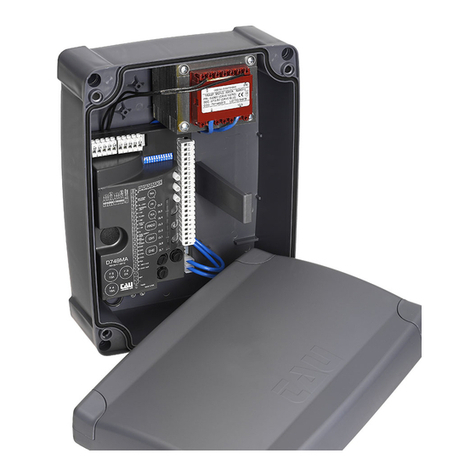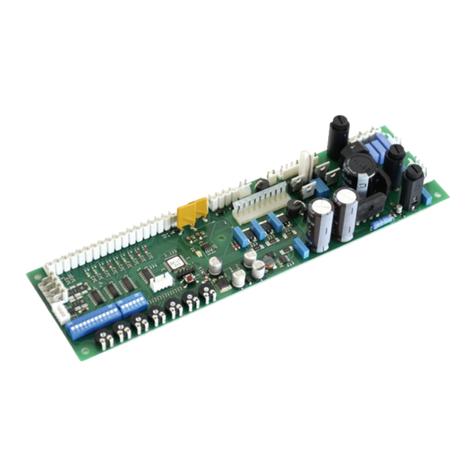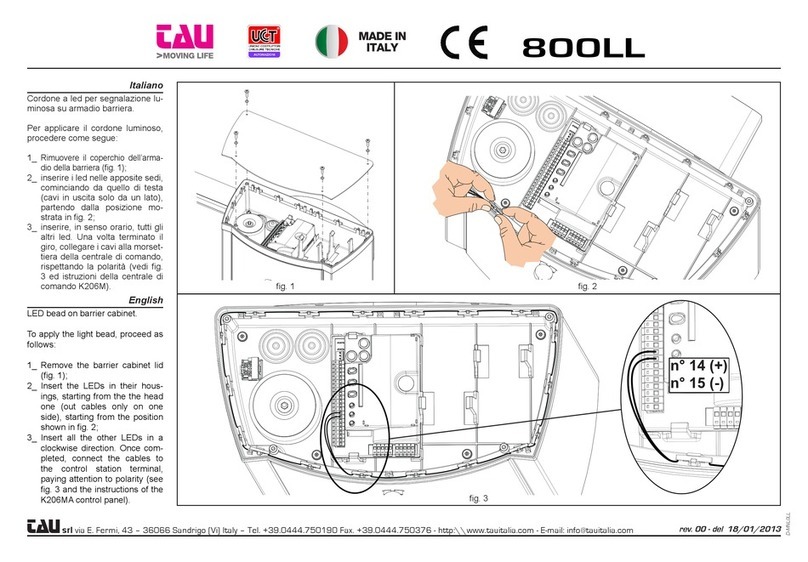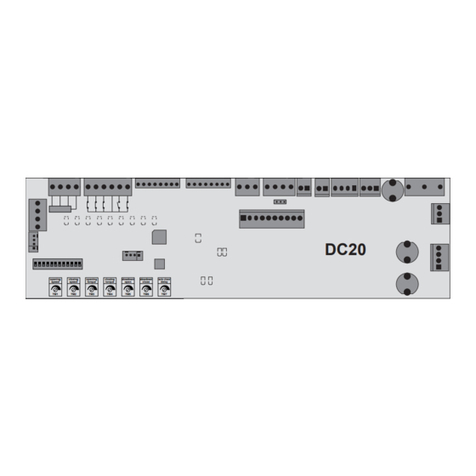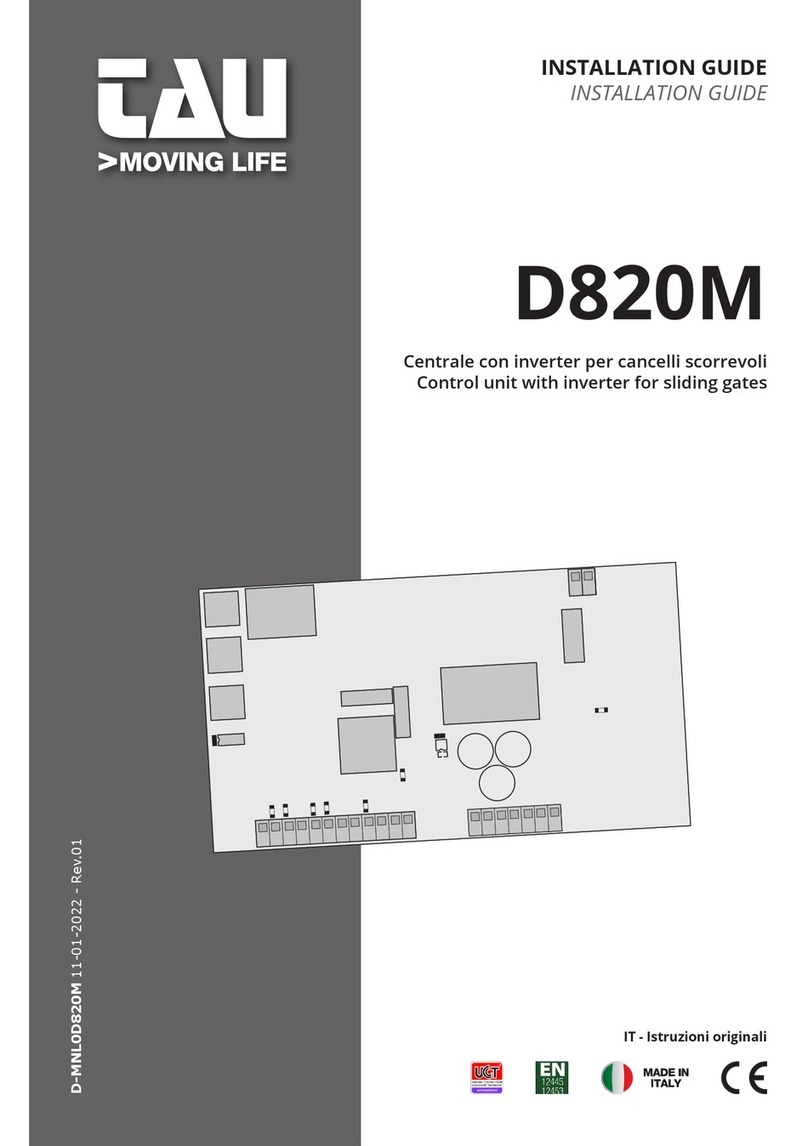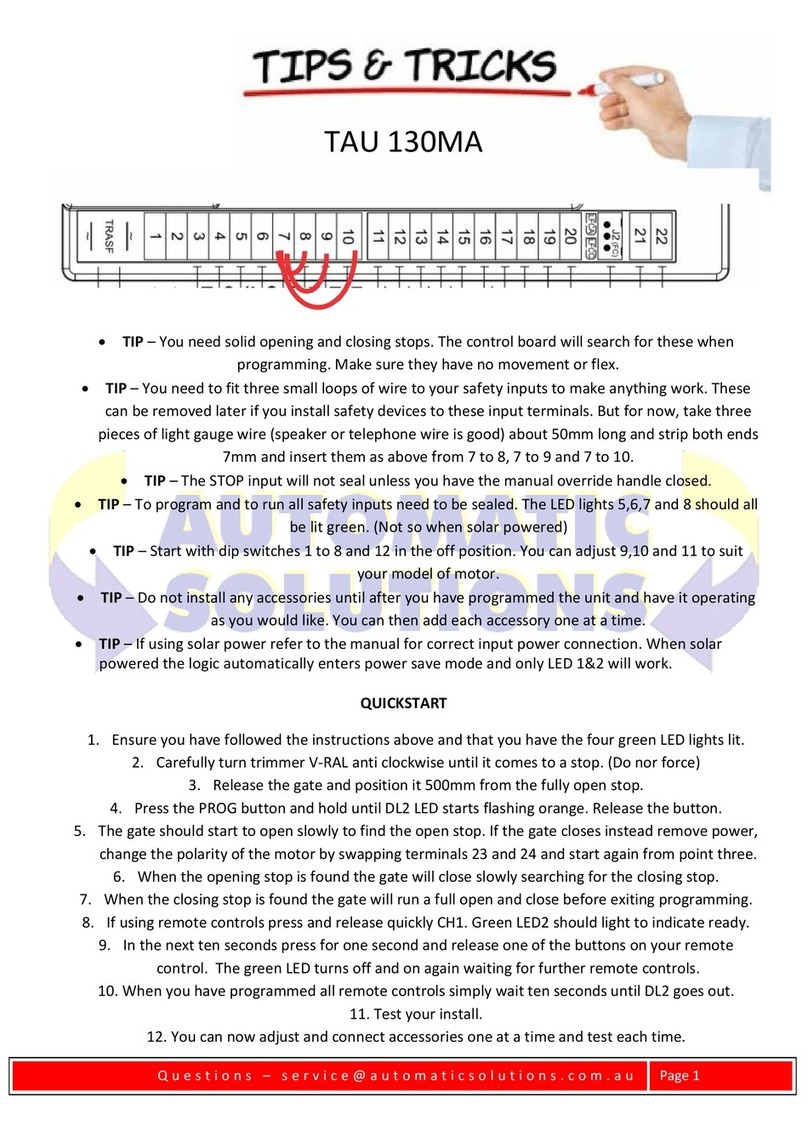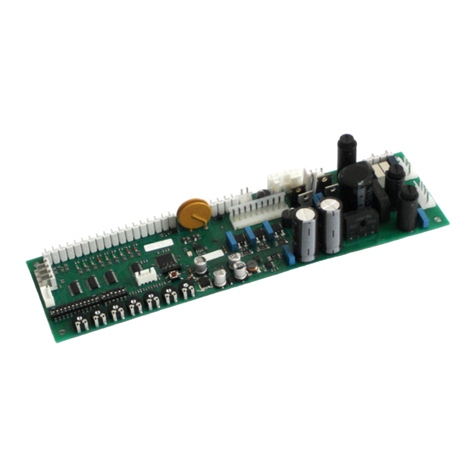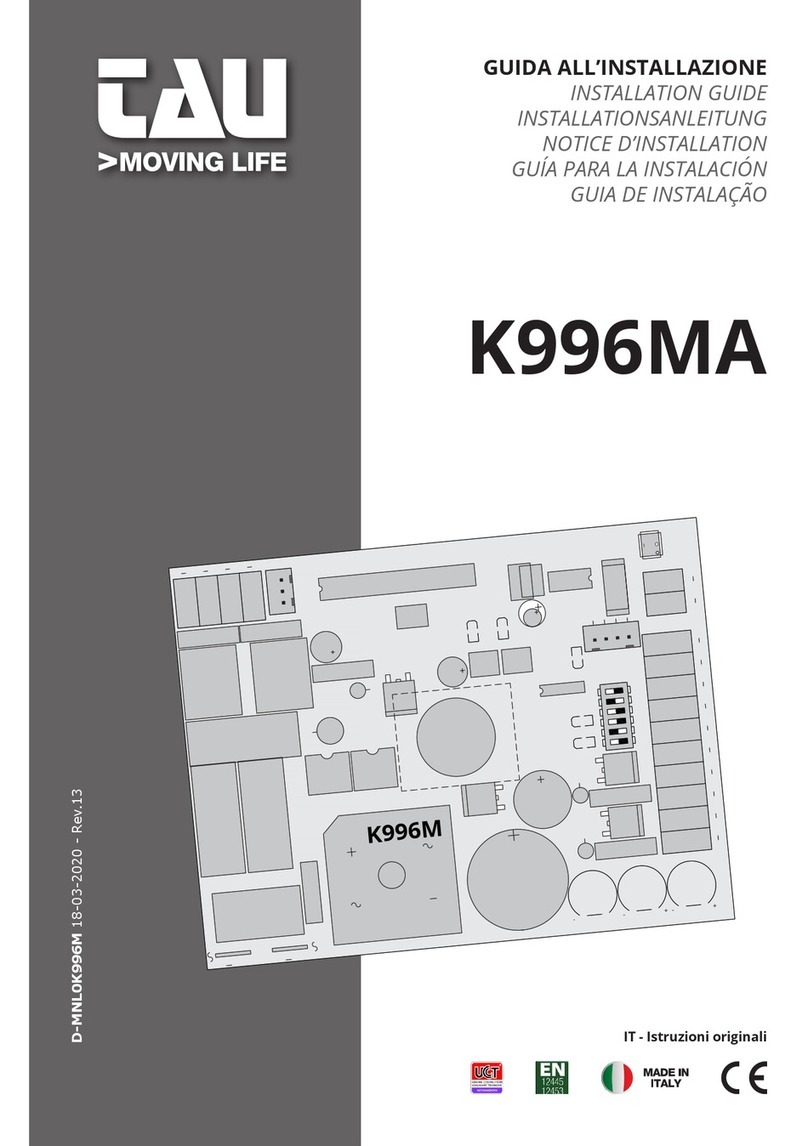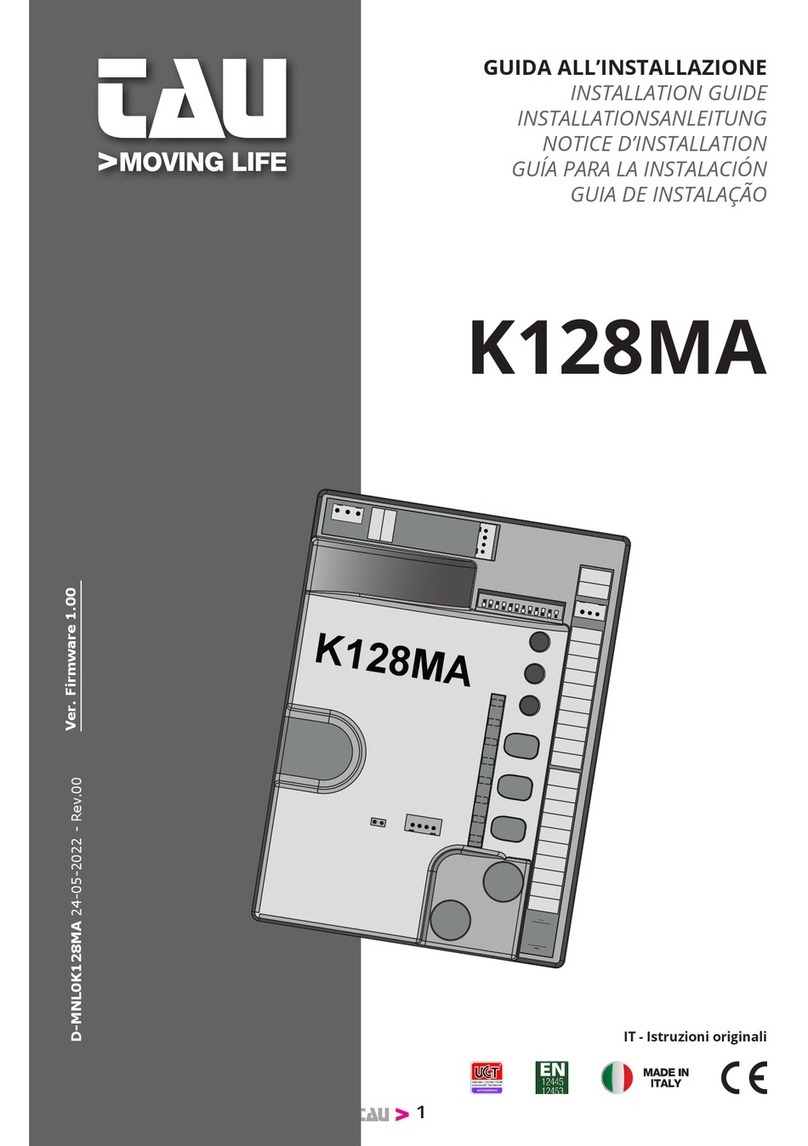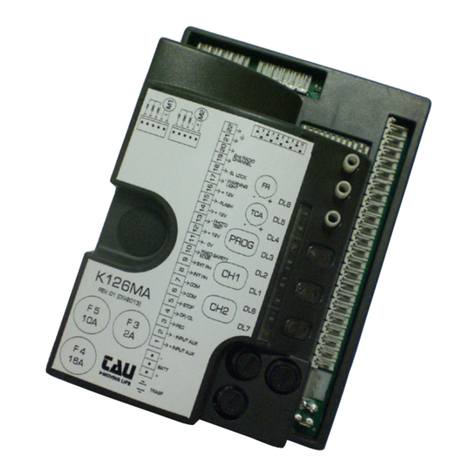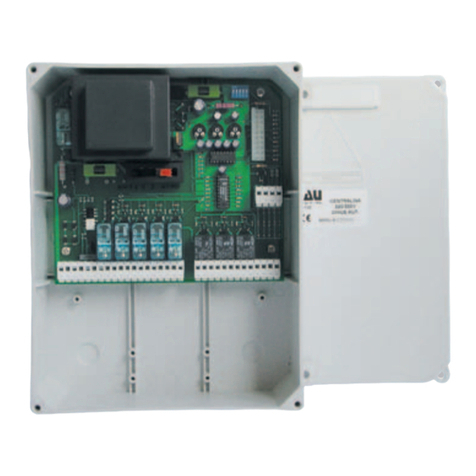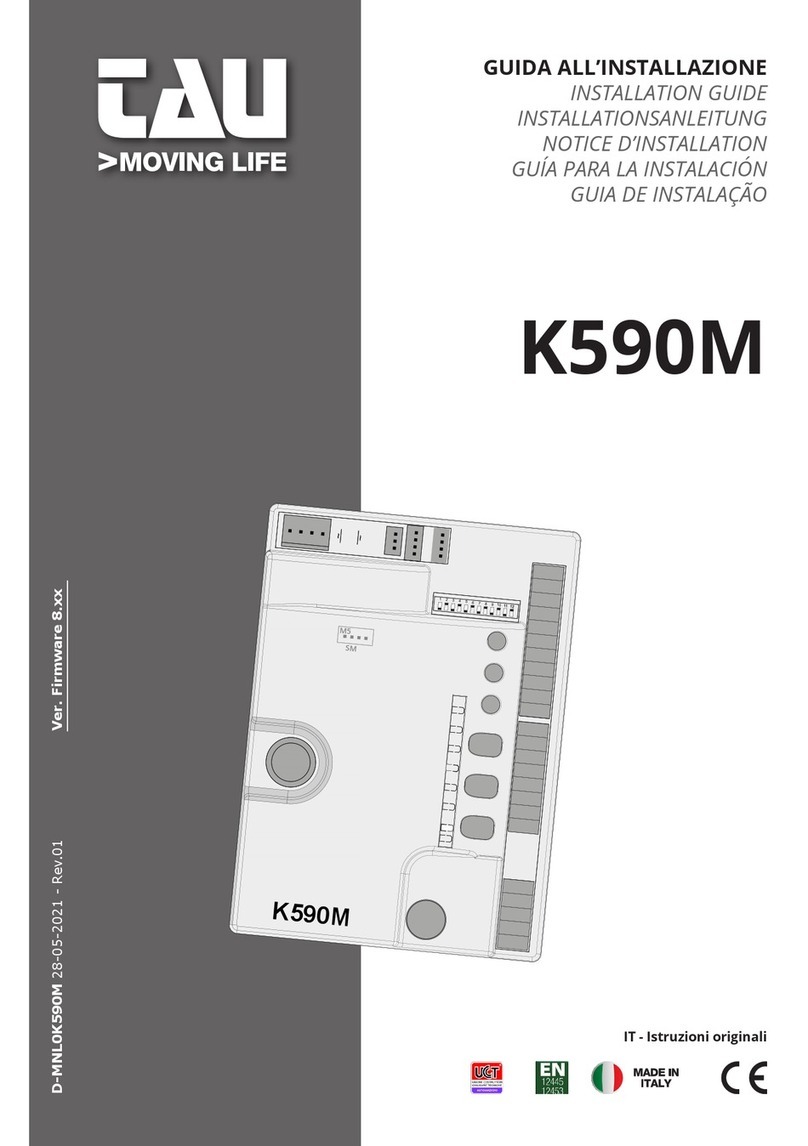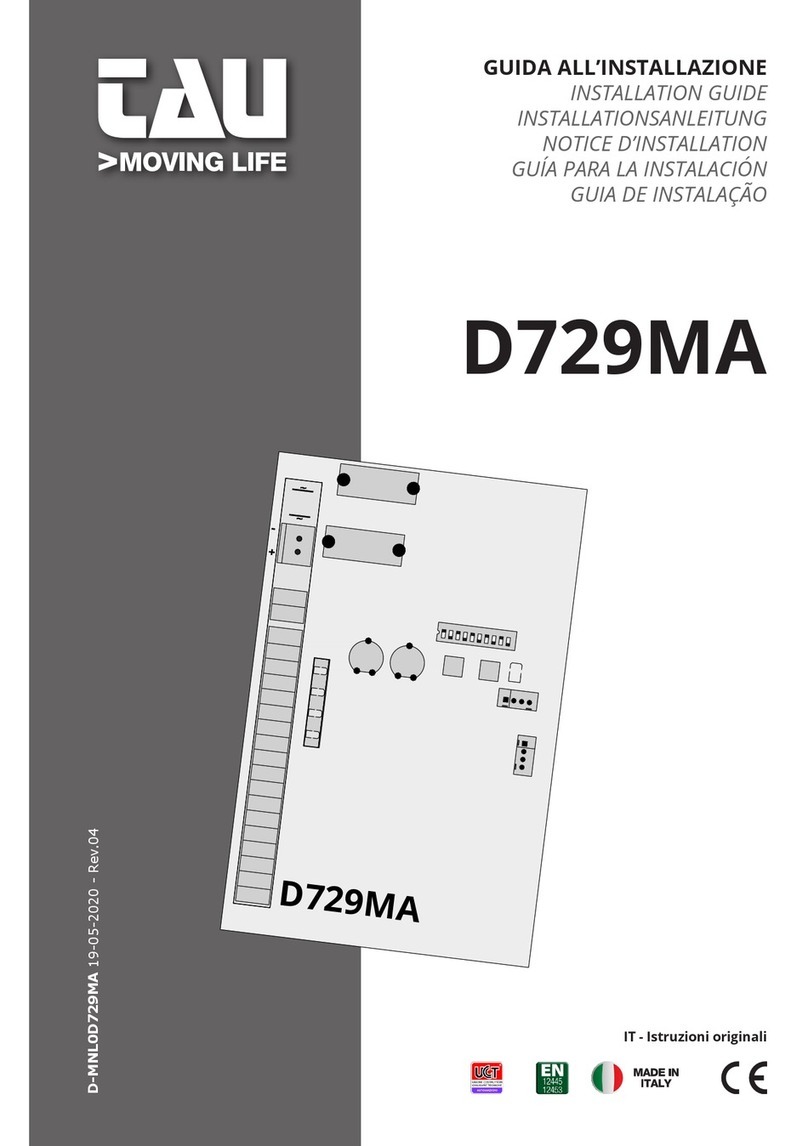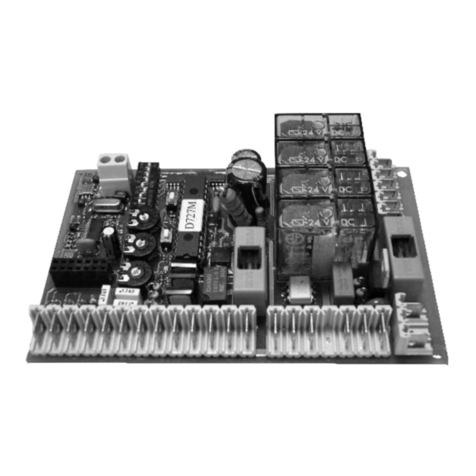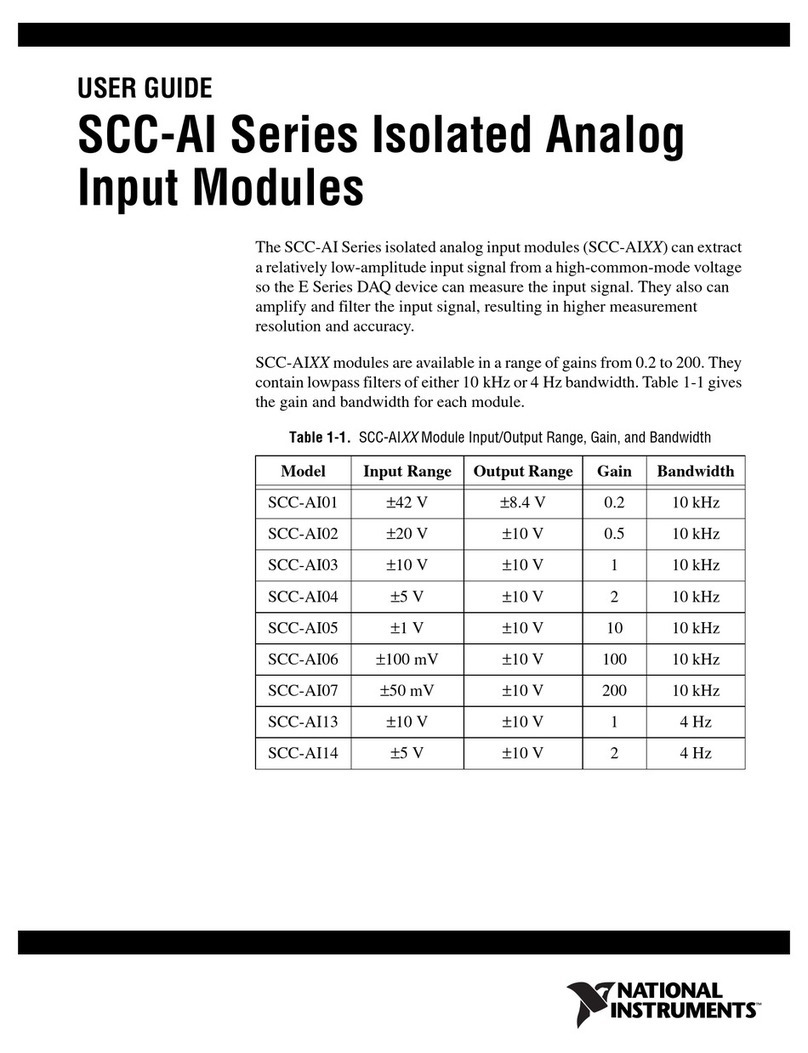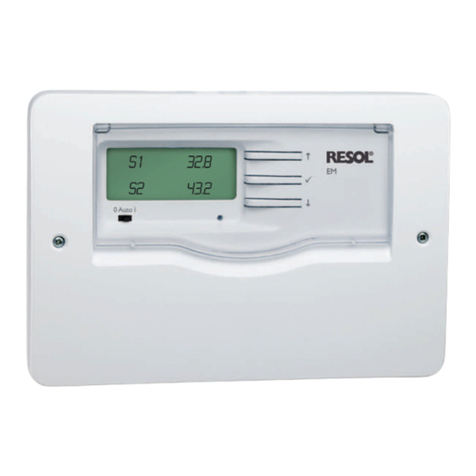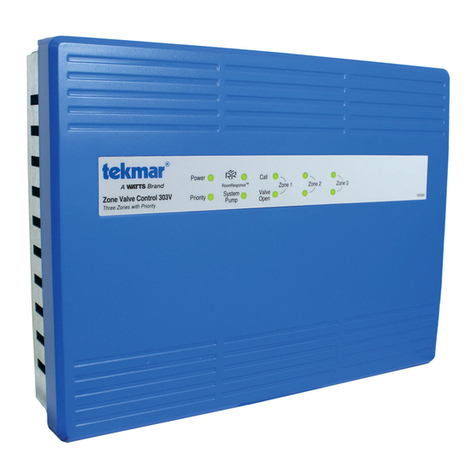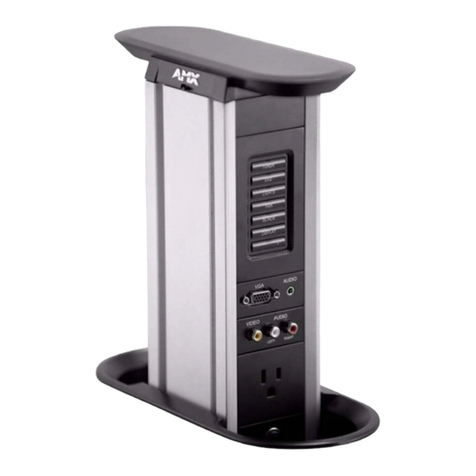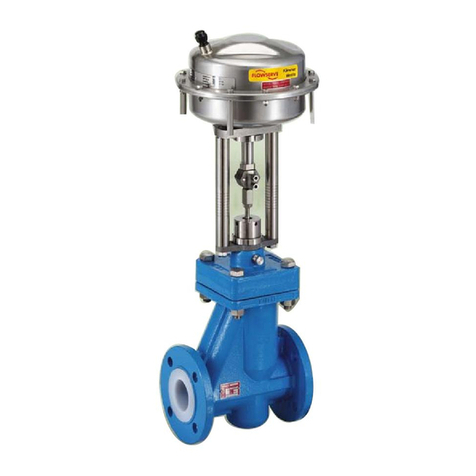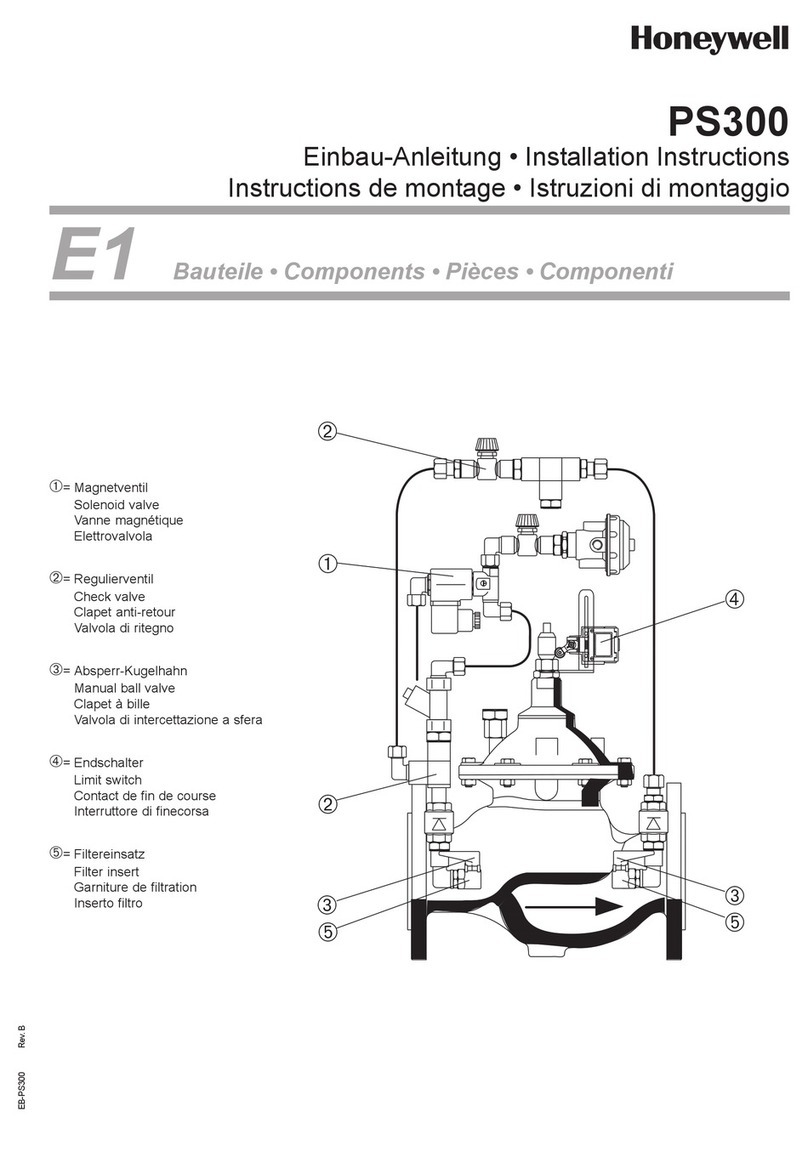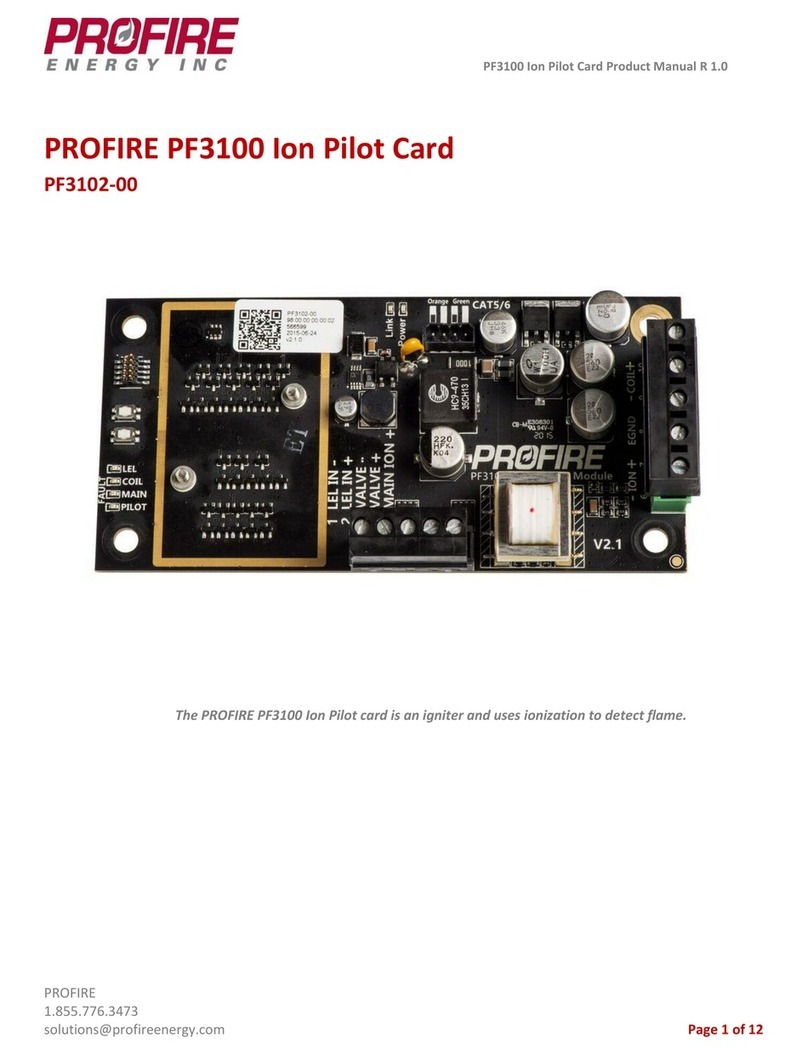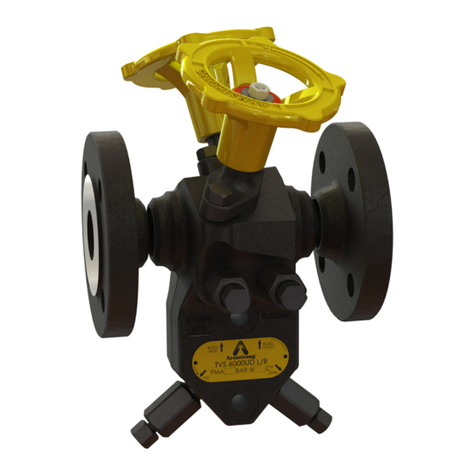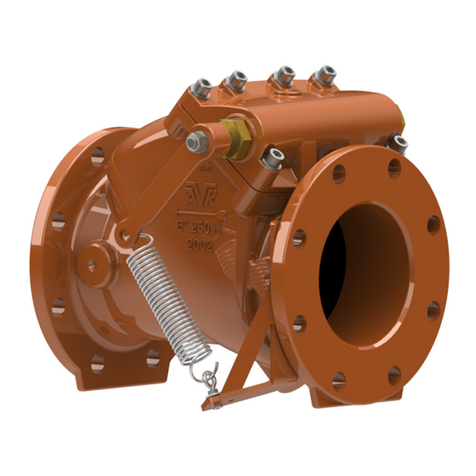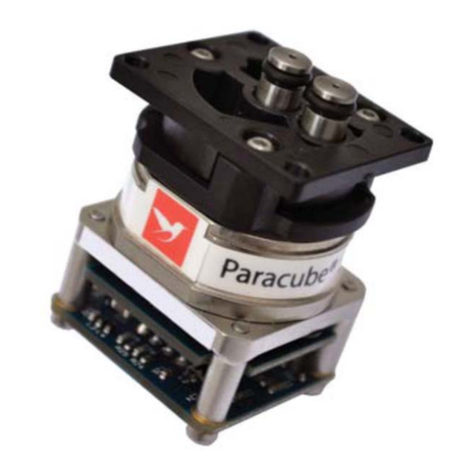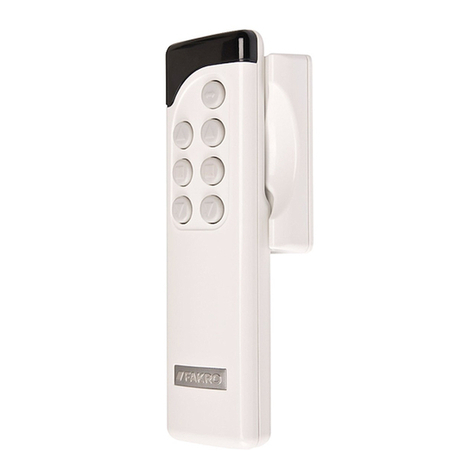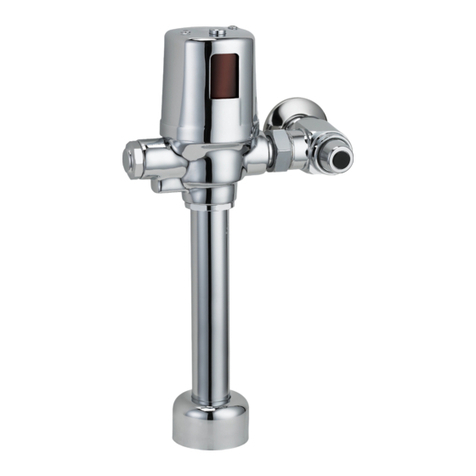tau K120M User manual

GUIDA ALL’INSTALLAZIONE
INSTALLATION GUIDE
INSTALLATIONSANLEITUNG
NOTICE D’INSTALLATION
GUÍA PARA LA INSTALACIÓN
GUIA DE INSTALAÇÃO
IT - Istruzioni originali
K120M
K120M
D-MNL0K120M 10-02-2022 - Rev.12

2
SCHEMA CABLAGGIO K120M / K120M WIRING DIAGRAM / SCHALTPLAN DER
RALL
FR
TCA
+
-
CH2
O/C
CH1
F1
16A
F3
2A
F2
10A
DL1
DL2
DL4
DL5
DL6
DL3
1 2 3 4 5 6 7 8 9
10
1 2 3 4 5 6 7 8 9 10
Flashing
light
24 Vdc
max. 20W
Common
- 0V
+ 24V
-
+ Photocell TX
-
+
-
+
Stop
Open/Close
Pedestrian
Gate open
warning light
max. 3W
2nd radio
channel
Antenna
K120M
Dip-switchesON
GND
GND
+5V
+5V
ENC
ENC
BATT
M5
M6
DL1
DL2
DL4
DL5
DL6
DL3
PEDESTRIAN
OPEN/CLOSE
STOP
PHOTO
SENSITIVE EDGE
ERROR
TCA
+-
FR
+-
RALL
+-
FS1
TRASF
FS2
1
2
3
4
5
6
7
8
9
10
11
12
13
14
15
16
17
18
19
23 22 212024
Fixed safety edge
Photocell
Common
Photocells
RX
12345
TX
1 2
M

3
K120M / SCHÉMA CÂBLAGE K120M / ESQUEMA DEL CABLEADO K120M
RALL
FR
TCA
+
-
CH2
O/C
CH1
F1
16A
F3
2A
F2
10A
DL1
DL2
DL4
DL5
DL6
DL3
1 2 3 4 5 6 7 8 9 10
1 2 3 4 5 6 7 8 9 10
Flashing
light
24 Vdc
max. 20W
Common
- 0V
+ 24V
-
+ Photocell TX
-
+
-
+
Stop
Open/Close
Pedestrian
Gate open
warning light
max. 3W
2nd radio
channel
Antenna
K120M
Dip-switchesON
GND
GND
+5V
+5V
ENC
ENC
BATT
M5
M6
DL1
DL2
DL4
DL5
DL6
DL3
PEDESTRIAN
OPEN/CLOSE
STOP
PHOTO
SENSITIVE EDGE
ERROR
TCA
+-
FR
+-
RALL
+-
FS1
TRASF
FS2
1
2
3
4
5
6
7
8
9
10
11
12
13
14
15
16
17
18
19
23 22 212024
Fixed safety edge
Photocell
Common
Photocells
RX
12345
TX
1 2
M

4
DICHIARAZIONE DI INCORPORAZIONE DEL COSTRUTTORE
(ai sensi della Direttiva Europea 2006/42/CE AlI. II.B)
Fabbricante: TAU S.r.l.
Indirizzo: Via E. Fermi, 43
36066 Sandrigo (Vi)
ITALIA
Dichiara sotto la propria responsabilità che il prodotto: Centrale di comando
realizzato per il movimento automatico di: Cancelli Scorrevoli
per uso in ambiente: Residenziale / Condominiale
completo di: Radioricevente
Modello: K120M
Tipo: K120M
Numero di serie: vedi etichetta argentata
Denominazione commerciale: Quadro di comando per motoriduttore T-ONE3B
È realizzato per essere incorporato su una chiusura (cancello scorrevole) o per essere assemblato con altri di-
spositivi al ne di movimentare una tale chiusura per costituire una macchine ai sensi della Direttiva Macchine
2006/42/CE.
Dichiara inoltre che questo prodotto è conforme ai requisiti essenziali di sicurezza delle seguenti ulteriori
direttive CEE:
- 2006/95/CE Direttiva Bassa Tensione
- 2004/108/CE Direttiva Compatibilità Elettromagnetica
ed, ove richiesto, alla Direttiva:
- 1999/5/CE Apparecchiature Radio e apparecchiature terminali di telecomunicazione
Dichiara inoltre che non è consentito mettere in servizio il macchinario no a che la macchina in cui sarà
incorporato o di cui diverrà componente sia stata identicata e ne sia stata dichiarata la conformità alle con-
dizioni della Direttiva 2006/42/CE.
Si impegna a trasmettere, su richiesta adeguatamente motivata delle autorità nazionali, informazioni perti-
nenti sulle quasi-macchine.
Sandrigo, 27/11/2014
Il Rappresentante Legale
_________________________________________
Loris Virgilio Danieli
Nome e indirizzo della persona autorizzata a costituire la documentazione tecnica pertinente:
Loris Virgilio Danieli - via E. Fermi, 43 - 36066 Sandrigo (Vi) Italia
ITALIANO

5
AVVERTENZE
Il presente manuale è destinato solamente al personale tecnico quali cato per l’installazione.
Nessuna informazione contenuta nel presente fascicolo può essere considerata d’interesse per l’utilizzatore
nale. Questo manuale è allegato alla centralina K120M, non deve pertanto essere utilizzato per prodotti diversi!
Avvertenze importanti:
Togliere l’alimentazione di rete alla scheda prima di accedervi.
La centralina K120M è destinata al comando di un motoriduttore elettromeccanico per l’automazione di can-
celli, porte e portoni.
Ogni altro uso è improprio e, quindi, vietato dalle normative vigenti.
È nostro dovere ricordare che l’automazione che state per eseguire, è classicata come “costruzione di una
macchina” e quindi ricade nel campo di applicazione della direttiva europea 2006/42/CE (Direttiva Macchine).
Questa, nei punti essenziali, prevede che:
- l’installazione deve essere eseguita solo da personale qualicato ed esperto;
- chi esegue l’installazione dovrà preventivamente eseguire “l’analisi dei rischi” della macchina;
- l’installazione dovrà essere fatta a “regola d’arte”, applicando cioè le norme;
- inne dovrà essere rilasciata al proprietario della macchina la”dichiarazione di conformità”.
Risulta chiaro quindi che l’installazione ed eventuali interventi di manutenzione devono essere eettuati solo da
personale professionalmente qualicato, in conformità a quanto previsto dalle leggi, norme o direttive vigenti.
Nella progettazione delle proprie apparecchiture, TAU rispetta le normative applicabili al prodotto (vedere la di-
chiarazione di conformità allegata); è fondamentale che anche l’installatore, nel realizzare gli impianti, prosegua
nel rispetto scrupoloso delle norme.
Personale non qualicato o non a conoscenza delle normative applicabili alla categoria dei “cancelli e porte
automatiche” deve assolutamente astenersi dall’eseguire installazioni ed impianti.
Chi non rispetta le normative è responsabile dei danni che l’impianto potrà causare!
Si consiglia di leggere attentamente tutte le istruzioni prima di procedere con l’installazione.
INSTALLAZIONE
Prima di procedere assicurarsi del buon funzionamento della parte meccanica. Vericare inol-
tre che il gruppo motoriduttore sia stato installato correttamente seguendo le relative istru-
zioni. Eseguiti questi controlli, assicurarsi che il motoriduttore non abbia un assorbimento du-
rante il movimento superiore a 3 A (per un corretto funzionamento del quadro di comando).
Vericare che il cancello scorra liberamente su un piano orizzontale (cancelli che aprono/chiudono su
piani in pendenza possono pregiudicare il funzionamento e la durata della centrale e del motoriduttore).
L’INSTALLAZIONE DELL’APPARECCHIATURA DEVE ESSERE EFFETTUATA “A REGOLA D’ARTE” DA PERSO-
NALE QUALIFICATO COME DISPOSTO DAL D.M. 37/08.
NB : si ricorda l’obbligo di mettere a massa l’impianto nonché di rispettare le normative sulla sicurezza
in vigore in ciascun paese.
LA NON OSSERVANZA DELLE SOPRAELENCATE ISTRUZIONI PUÒ PREGIUDICARE IL BUON FUNZIO-
NAMENTO DELL’APPARECCHIATURA E CREARE PERICOLO PER LE PERSONE, PERTANTO LA “CASA CO-
STRUTTRICE” DECLINA OGNI RESPONSABILITÀ PER EVENTUALI MAL FUNZIONAMENTI E DANNI DOVUTI
ALLA LORO INOSSERVANZA.
1. SCHEDA COMANDO PER MOTORIDUTTORE T-ONE3B
• LOGICA CON MICROPROCESSORE
• STATO DEGLI INGRESSI VISUALIZZATO DA LEDs
• PROTEZIONE INGRESSO LINEA CON FUSIBILE
• FUNZIONE “INGRESSO PEDONALE”
• CIRCUITO DI LAMPEGGIO INCORPORATO
• RADIO RICEVITORE 433,92 MHz INTEGRATO A 2 CANALI (CH)
• CONNETTORE PER BATTERIA
• SENSORE AD ENCODER PER RILEVAMENTO OSTACOLI ED AUTOAPPRENDIMENTO DELLA CORSA
• RALLENTAMENTO REGOLABILE
ITALIANO

6
• DIAGNOSTICA DEL DIFETTO FUNZIONE VISUALIZZATO DA LED
• EN CONFORME E CERTIFICABILE FINO A 400 KG DI ANTA
ATTENZIONE:
- non utilizzare cavi unilari (a conduttore unico), es. quelli citofonici, al ne di evitare inter-
ruzioni sulla linea e falsi contatti;
- non riutilizzare vecchi cavi preesistenti.
- In caso di lunghi tratti di cavi ( > 20 m) per i comandi N.A. / N.C. (es: APRE/CHIUDE, STOP,
PEDONALE, ecc), al ne di evitare malfunzionamenti del cancello si renderà necessario disac-
coppiare i vari comandi mediante RELAYS oppure utilizzando il nostro dispositivo 750T-RELE.
2. COLLAUDO
A collegamento ultimato:
•I Leds verdi devono essere tutti accesi (corrispondono ciascuno ad un ingresso Normalmente Chiu-
so). Si spengono solo quando sono interessati i comandi ai quali sono associati.
•I Leds rossi devono essere tutti spenti (corrispondono ciascuno ad un ingresso Normalmente
Aperto) si accendono solo quando sono interessati i comandi ai quali sono associati. Fa eccezione
il led di diagnostica DL3 che deve essere sempre acceso.
3. CARATTERISTICHE TECNICHE
Alimentazione scheda 18,5 V AC - 50 Hz
Potenza max. motore c.c. 50 W - 24 V DC
Fusibile rapido protezione alimentazione ingresso 13,5 Vac (F1 - 5x20) F 16 A
Fusibile rapido protezione motore (F2 - 5x20) F 10 A
Fusibile rapido protezione ausiliari 24 V DC (F3 - 5x20) F 2 A
Tensione circuiti alimentazione motore 24 V DC
Tensione alimentazione circuiti dispositivi ausiliari 24 V DC
Tensioni alimentazioni circuiti logici 5 V DC
Temperatura di funzionamento -20 °C ÷ +70 °C
Grado di protezione del contenitore IP 44
4. COLLEGAMENTI ALLA MORSETTIERA
Morsetti Funzione Descrizione
FS1 - FS2 ALIMENTAZIONE ingresso alimentazione scheda 18,5 V AC - Alimentato dal trasformatore
toroidale riposto nell’apposito vano del motore T-ONE3B e protetto da fu-
sibile sull’alimentazione 230 V AC.
1 - 3 BORDO
SENSIBILE
ingresso BORDO SENSIBILE (Bordo sensibile resistivo o costa ssa); Funziona solo
durante la fase di apertura e provoca la fermata temporanea del cancello e una
parziale richiusura dello stesso per circa 20 cm. liberando così l’eventuale ostacolo.
1= BORDO SENSIBILE, 3= COMUNE.
Nota: se si collega un bordo sensibile resistivo porre il dip-switch nr 9 in ON;
Se si collega una costa ssa con contatto NC porre il dip-switch nr 9 in OFF.
2 - 3 FOTOCELLULE
ingresso FOTOCELLULE O DISPOSITIVI DI SICUREZZA attivi in chiusura (contat-
to Normalmente Chiuso); il loro intervento, in fase di chiusura provoca l’arre-
sto seguito dalla totale riapertura del cancello, in fase di apertura provoca la
fermata temporanea del cancello no a rimozione dell’ostacolo rilevato (solo
se programmato dip switch nr. 3 in ON). Nel caso di più dispositivi di sicurezza,
collegare tutti i contatti NC in serie.2= FOTOCELLULA.
Nota: Il trasmettittore della fotocellula deve sempre essere alimentato
dai morsetti nr 10 - 11, in quanto su di esso si eettua la verica del
sistema di sicurezza (Fototest). Per eliminare la verica del sistema di
sicurezza, o quando non si usano le fotocellule, porre il dip-switch nr 6 in
OFF. Se il fototest non va a buon ne, la centralina non funziona.
ITALIANO

7
4 - 5 STOP
ingresso pulsante STOP (contatto Normalmente Chiuso); Arresta il cancello
dovunque si trovi, inibendo temporaneamente la chiusura automatica, se
programmata. 4= COMUNE, 5= STOP.
Nota: al pulsante STOP è collegato un microinterruttore di sicurezza
sblocco. Se l’ingresso STOP rimane aperto per più di 5 secondi, la suc-
cessiva manovra sarà di RIALLINEAMENTO (vedi “Ripristino funziona-
mento automatico”). Il microinterrutore va collegato in serie ad altri
eventuali pulsanti di STOP.
4 - 6 APRE/CHIUDE
ingresso pulsante APRE/CHIUDE
(contatto Normalmente Aperto);
Comanda l’apertura e la chiusura del cancello ed è regolato nel funziona-
mento dai dip-switches 2 e 4.
6= APRE/CHIUDE.
4 - 7 PEDONALE ingresso pulsante PEDONALE (contatto Normalmente Aperto); Comanda
l’apertura e la chiusura parziale del cancello per ~1 m di corsa ed è regolato
nel funzionamento dai dip-switches 2 e 4. 7= PEDONALE.
8 - 9 FOTOCELLULE uscita 24 VDC, max. 15 W, per l’ALIMENTAZIONE DELLE RX ED EVENTUALI
ALTRI TX DELLE FOTOCELLULE, RICEVITORI ESTERNI, etc; collegare max. n°
3 coppie di fotocellule. 8= NEGATIVO, 9= POSITIVO.
10 - 11 TX
FOTOCELLULE
uscita 24 V DC, per l’ALIMENTAZIONE DEL TX DELLE FOTOCELLULE (solo
quello che eettua il Fototest);
max. nr. 1 trasmettitore fotocellule.
10= NEGATIVO, 11= POSITIVO.
12 - 13 LAMPEGGIANTE uscita LAMPEGGIANTE 24 V DC, max. 20 W. Il segnale fornito è già oppor-
tunamente modulato per l’uso diretto. La frequenza di lampeggio è doppia
in fase di chiusura. 12= NEGATIVO, 13= POSITIVO.
14 - 15 SPIA CANCELLO
APERTO
uscita per SPIA CANCELLO APERTO 24 V DC, max. 3 W; durante l’apertura del
cancello la spia lampeggia lentamente, a cancello aperto resta accesa e du-
rante la chiusura lampeggia a velocità doppia. 14= NEGATIVO, 15= POSITIVO.
16 - 17 2° CANALE
RADIO
uscita 2° CANALE RADIO (il suo funzionamente dipende dai dip-switch nr
7 - 8) da utilizzarsi per aprire/chiudere un altro cancello o per comandare
le luci del giardino, o per la funzione “ILLUMINAZIONE DI ZONA”.
Nota: per il collegamento di altri dispositivi al 2° canale radio, quali
accensione luci, comando pompe o carichi importanti, utilizzare un
relè ausiliario di potenza con portata adeguata ai dispositivi da col-
legare, altrimenti si potrebbero avere malfunzionamenti dovuti a
disturbi indotti.
18 - 19 ANTENNA Ingresso ANTENNA per RX 433,92 MHz incorporata.
18= MASSA, 19= SEGNALE.
M5 ENCODER innesto rapido per connessione ENCODER.
Bianco= 0 V DC (GND), marrone= 5 V DC (+5V),
verde= SEGNALE ENCODER (ENC).
20 - 21
- 22 ENCODER
alimentazione e ingresso encoder
20 bianco= 0 V DC (GND), 21 marrone= 5 V DC (+5V),
22 verde= SEGNALE ENCODER (ENC);
Dal 30/06/2017 i collegamenti dell’encoder sono:
20 verde = 0 V DC (GND), 21 mararone = 5 V DC (+5V)
22 bianco = SEGNALE ENCODER (ENC)
23 - 24 MOTORE
24V DC uscita alimentazione MOTORE 24 V DC max. 50 W.
23= NEGATIVO, 24= POSITIVO.
M6 BATTERIA innesto rapido per connessione BATTERIE 19,2 V DC - 1,2 Ah.
5. PROCEDURA DI MEMORIZZAZIONE
ATTENZIONE: Dopo aver alimentato il quadro di comando attendere 2 sec. prima di iniziare a
svolgere le manovre di regolazione.
Nota: il cancello deve necessariamente avere i fermi meccanici di sicurezza sia in apertura che
ITALIANO

8
in chiusura.
Terminata l’installazione dell’automazione:
1_ portare il cancello a 1 m ca. dalla battuta in chiusura;
2_ posizionare il dip-switch nr. 10 in ON;
3_ comandare l’automazione agendo su uno dei seguenti ingressi: A/C, radiocomando o pulsante scheda (O/C).
4_ il cancello deve cominciare a chiudere.
Nota: nel caso dovesse aprirsi, sospendere la programmazione resettando il quadro elettrico (togliere
l’alimentazione al quadro per almeno 5 sec. e rimettere il dip-switch nr. 10 in OFF), e quindi a qua-
dro disalimentato invertire tra di loro i li di alimentazione del motore. Riprendere poi la procedu-
ra dal punto 1.
5_ eettuata la chiusura, trascorso un tempo di circa 2 sec., viene eseguita automaticamente un’apertura totale;
6_ ad apertura completata, attendere che il led DL3 sia acceso sso, quindi posizionare il dip-switch nr. 10 in OFF;
7_ l’automazione è ora pronta per il funzionamento.
Eettuare le regolazioni logiche.
Nota: agendo su qualsiasi regolazione del quadro di comando (trimmer o dip-switches) è necessario
eettuare una manovra completa (apertura e chiusura) dell’automazione per rendere attive le
nuove impostazioni.
6. REGOLAZIONI LOGICHE
TRIMMER
RALL. Regolazione rallentamento: da 0 a 150 cm circa prima del necorsa;
Nota: prima di impostare il rallentamento, l’automazione deve eseguire
una manovra completa di apertura e chiusura.
FR. Regolazione sensibilità rilevamento ostacoli. Regolare il trimmer per una spinta
del cancello atta a garantire il funzionamento, facendo attenzione a non supe-
rare quella consentita dalle norme in uso (EN 12453). Ruotando il trimmer in
senso orario (+) si aumenta la coppia motore, viceversa, ruotandolo in senso
antiorario (-), diminuisce.
T.C.A. Regolazione Tempo di Chiusura Automatica: da 3 a 255 secondi ca. (vedi dip-
switch nr. 1);
RALL
FR
TCA
+-
+-
+-
Dip switch
1CHIUSURA
AUTOMATICA
On ad apertura completata, la chiusura del cancello è automatica trascor-
so un tempo impostato sul trimmer T.C.A.;
O la chiusura necessita di un comando manuale;
22 / 4 TEMPI
On ad automazione funzionante, una sequenza di comandi di apertura/
chiusura induce il cancello ad una APERTURA-CHIUSURA-APERTURA-
CHIUSURA, etc. (vedi anche dip switch 4);
O nelle stesse condizioni, la stessa sequenza di comandi di apertura/
chiusura induce il cancello ad una APERTURA-STOP-CHIUSURA-STOP-
APERTURA-STOP, etc. (funzione passo-passo);
3INTERVENTO
FOTOCELLULE
IN APERTURA
On durante la fase di apertura la fotocellula interviene arrestando il can-
cello no a rimozione dell’ostacolo rilevato. Alla rimozione dell’ostacolo
il cancello riprende l’apertura;
O durante la fase di apertura la fotocellula non interviene;
4NO
REVERSE
On azionando il pulsante apre-chiude avremo una inversione di marcia
anche in fase di apertura;
O funzione NO-REVERSE attiva; il cancello ignora i comandi di chiusura
durante l’apertura e l’inversione di marcia avviene solo in fase di chiu-
sura;
5 PRE-
LAMPEGGIO
On la funzione prelampeggio è abilitata;
O la funzione prelampeggio è disabilitata;
6 FOTOTEST
On la funzione “verica delle fotocellule” è inserita;
O la funzione “verica delle fotocellule” è disinserita.
Nota: da utilizzare quando non si usano le fotocellule;
7 - 8 funzionamento 2° CANALE RADIO (morsetti nr 16 - 17)
ITALIANO

9
Dip 7 Dip 8 Funzione
O O Contatto cancello aperto: il contatto si attiva all’apertura del cancello, rimane
attivo durante il tempo di apertura, durante il TCA e durante la richiusura. Si
disattiva una volta che il cancello ha completato la chiusura.
O On Funzione bistabile attiva: all’impulso del radiocomado il contatto si attiva e rimane
tale no al successivo impulso.
On O Funzione monostabile attiva 2 sec.: all’impulso del radiocomado il contatto si
attiva e rimane tale per 2 sec.
On On Funzione monostabile attiva 180 sec.: all’impulso del radiocomado il contatto si
attiva e rimane tale per 180 sec.
9 BORDO
SENSIBILE
On BORDO SENSIBILE RESISTIVO (morsetto nr 1);
O COSTA FISSA (contatto NC - morsetto nr 1);
10 MEMO
On si abilita la funzione di memorizzazione per l’autoapprendimento della
corsa;
O posizione in cui lasciare il dip-switch al termine della procedura di me-
morizzazione.
7. LED DI DIAGNOSI
DL1 (PEDESTRIAN) led rosso di segnalazione pulsante PEDONALE
DL2 (OPEN/CLOSE) led rosso di segnalazione pulsante APRE/CHIUDE
DL3 (ERR) led rosso di segnalazione ERRORI
DL4 (STOP) led verde di segnalazione pulsante STOP
DL5 (PHOTO) led verde di segnalazione FOTOCELLULA
DL6 (SENSITIVE EDGE) led verde di segnalazione BORDO SENSIBILE
8. CARATTERISTICHE DELLA K120M
LED - DL3
Il led, oltre ad indicare la presenza dell’alimentazione, segnala eventuali errori con una serie di lam-
peggi predeniti:
sempre acceso: funzionamento regolare;
1 lampeggio: tensione della batteria tampone inferiore a 17,3 V DC;
Controllare l’alimentazione di rete, caricare la batteria, sostituire la batteria;
2 lampeggi: errore fototest;
Disabilitare fototest (dip-switch 6 in OFF), vericare funzionamento fotocellule e loro collegamento;
3 lampeggi: mancanza tensione di rete;
Controllare interruttore magnetotermico (a monte dell’impianto), controllare fusibili;
4 lampeggi: superamento limite max. di corrente;
Picco di eccessivo assorbimento del motoriduttore, controllare l’assenza di ostacoli lungo la corsa del cancel-
lo, vericare l’assorbimento di corrente del motore a vuoto e applicato al cancello;
5 lampeggi: assenza segnale encoder;
Controllare cablaggio, vericare encoder tramite TEST-ENCODER (opzionale), vericare che il motore giri
liberamente alimentato direttamente dalla batteria, vericare fusibile F2;
6 lampeggi: presenza ostacolo dopo 5 tentativi di chiusura falliti;
Controllare l’assenza di ostacoli lungo la corsa del cancello e la scorrevolezza dello stesso;
7 lampeggi: non è stata eseguita alcuna procedura di memorizzazione;
Eseguire procedura di memorizzazione.
ITALIANO

10
8 lampeggi: assenza segnale motore;
Controllare cablaggio, vericare che il motore giri liberamente alimentato direttamente dalla batteria, veri-
care fusibile F2.
L’indicazione di più errori viene eseguita con una pausa di 2 sec. tra una segnalazione e l’altra.
Nel caso di 5 interventi consecutivi (durante la stessa manovra di chiusura) da parte dell’encoder (rile-
vazione ostacolo), la centrale apre completamente segnalando l’errore con la serie di lampeggi previ-
sti. Al successivo impulso di comando, smetterà di lampeggiare ed entrerà in fase di corsa rallentata
alla ricerca della battuta in chiusura.
Nel caso di 5 interventi consecutivi (durante la stessa manovra di chiusura) da parte delle fotocellule
(rilevazione ostacolo), la centrale apre completamente e si ferma senza lampeggiare. È necessario un
nuovo impulso di comando per completare la chiusura.
RILEVAMENTO OSTACOLI
La funzione di rilevamento ostacoli (impostabile tramite trimmer FR) intervenendo in fase di apertura
dell’automazione provoca una richiusura della stessa di 20 cm ca., mentre in fase di chiusura provoca
un’apertura totale.
ATTENZIONE: la logica del quadro di comando può interpretare un attrito meccanico come un
eventuale ostacolo.
RALLENTAMENTO
Per evitare che il cancello sbatta alla ne della corsa, è possibile impostare (tramite il trimmer RALL) il
rallentamento in apertura e in chiusura su una distanza variabile da 10 a 150 cm. (ruotando il trimmer
in senso orario si aumenta la distanza di rallentamento; viceversa, ruotandolo in senso antiorario la
distanza di rallentamento si accorcia). Si consiglia di impostare la distanza di rallentamento tenendo
conto del peso del cancello e degli attriti meccanici in gioco.
Nota: il pulsante O/C della scheda ha la stessa funzione del tasto APRE/CHIUDE.
9. RIPRISTINO FUNZIONAMENTO AUTOMATICO
Qualora si renda necessario movimentare manualmente la chiusura o l’apertura del cancello, azionare
lo sblocco manuale. Per ripristinare il normale funzionamento (in automatico), occorre specicare:
• se il ripristino avviene successivamente ad un black-out (la scheda resta priva di alimentazione per
un certo tempo), il cancello entrerà in fase di corsa rallentata alla ricerca della battuta di chiusura;
• se il ripristino avviene dopo un intervento manuale (senza interruzioni all’alimentazione della sche-
da), saranno necessarie 4 o 5 manovre complete per fare riallineare il cancello, durante le quali
non verranno osservati i normali rallentamenti e le conseguenti battute d’arresto.
10. FUNZIONI AVANZATE
Funzione orologio: è possibile utilizzare un timer (esempio settimanale) collegato all’ingresso del pul-
sante apre-chiude per mantenere aperto il cancello in determinate fascie orarie e permetterne poi la
richiusura automatica.
Nota: il cancello rimane aperto nchè l’ingresso Ap/Ch rimane impegnato.
Funzione “solo Apre”: ponendo il dip 1 in ON ed il dip 4 in OFF, l’ingresso Ap/Ch funzionerà solo come
comando di apertura, mentre il cancello chiuderà esclusivamente una volta trascorso il tempo di chiu-
sura automatica.
Funzione “contatto cancello aperto”: ponendo il dip 7 ed il dip 8 in OFF, il 2° ch radio (morsetti nr 16
- 17) funzionerà da contatto pulito che indica quando il cancello è aperto. È possibile utilizzare questa
funzione per collegare una “ILLUMINAZIONE DI ZONA” o come segnalazione di cancello aperto.
11. RADIO RICEVITORE 433,92 MHz INTEGRATO
Il radio ricevitore può apprendere no ad un max di 30 codici rolling code (BUG2R, BUG4R, KSLIM-RP,
T-4RP) da impostare liberamente su due canali.
ITALIANO

11
Il primo canale comanda direttamente la scheda di comando per l’apertura dell’automazione; il secon-
do canale comanda un relè per un contatto pulito N.A. in uscita ai morsetti nr 16 e 17 (max 24 Vac, 1 A).
APPRENDIMENTO RADIOCOMANDI
CH1 = APRE/CHIUDE CH2 = 2° canale
1_ premere brevemente il tasto CH1 se si desidera associare un radiocomando alla funzione APRE/
CHIUDE;
2_ il led DL3 si spegne per indicare la modalità di apprendimento dei codici (se non viene immesso
nessun codice entro 10 secondi, la scheda esce dalla modalità di programmazione);
3_ premere il tasto del radiocomando che si desidera utilizzare;
4_ il led DL3 si riaccende per segnalare l’avvenuta memorizzazione (se ciò non accade, attendere 10
secondi e riprendere dal punto 1);
5_ se si desidera memorizzare altri radiocomandi, ripetere la procedura dal punto 1 no ad un mas-
simo di 30 trasmettitori;
6_ se si desidera eettuare la memorizzazione sul 2° canale, ripetere la procedura dal punto 1 utiliz-
zando il tasto CH2 anzichè il tasto CH1;
7_ se si desidera uscire dalla modalità di apprendimento senza memorizzare un codice, premere
brvemente il tasto CH1 o il tasto CH2.
Nota: nel caso di raggiungimento del nr massimo di radiocomandi (nr 30), il led DL3 inizierà a
lampeggiare velocemente per circa 3 secondi senza però eseguire la memorizzazione.
PROGRAMMAZIONE REMOTA TRAMITE T-4RP e K-SLIM-RP (V 4.X)
Con la versione di software V 4.X è possibile eseguire l’apprendimento remoto con i radiocomandi
T-4RP e K-SLIM-RP (V 4.X), ossia senza agire direttamente sui tasti di programmazione della ricevente.
Sarà suciente disporre di un radiocomando già programmato nella ricevente per poter aprire la
procedura di programmazione remota dei nuovi radiocomandi. Seguire la procedura riportata sulle
istruzioni del radiocomando T-4RP e K-SLIM-RP (V 4.X).
CANCELLAZIONE RADIOCOMANDI
1_ tenere premuto per 3 secondi ca. il tasto CH1 al ne di cancellare tutti i radiocomandi ad esso
associati;
2_ il led DL3 inizia a lampeggiare lentamente per indicare che la modalità di cancellazione è attivata;
3_ tenere premuto nuovamente il tasto CH1 per 3 secondi;
4_ il led DL3 si spegne per 3 secondi ca. per poi riaccendersi sso ad indicare l’avvenuta cancellazione;
5_ riprendere la procedura dal punto 1 utilizzando il tasto CH2 per cancellare tutti i radiocomandi ad
esso associati;
6_ se si desidera uscire dalla modalità di cancellazione senza memorizzare un codice, premere breve-
mente il tasto CH1 o il tasto CH2.
12. MALFUNZIONAMENTI: POSSIBILI CAUSE E RIMEDI
L’automazione non parte
a_ Vericare con lo strumento (Multimetro) la presenza dell’alimentazione 230 V AC;
b_ Vericare che i contatti N.C. della scheda siano eettivamente normalmente chiusi (3 led verdi
accesi) e che i led rossi dei comandi di apertura siano spenti;
c_ Impostare il dip 6 (fototest) su OFF;
d_ Aumentare il trimmer FR al massimo;
e_ Controllare con lo strumento (Multimetro) che i fusibili siano integri.
Il radiocomando ha poca portata
a_ Controllare che il collegamento della massa e del segnale dell’antenna non sia invertito;
b_ Non eseguire giunzioni per allungare il cavo dell’antenna;
c_ Non installare l’antenna in posizioni basse o in posizioni nascoste dalla muratura o dal pilastro;
d_ Controllare lo stato delle pile del radiocomando.
Il cancello si apre al contrario
a_ Invertire il collegamento del motore (morsetti nr 23 - 24).
ITALIANO

12
13. GARANZIA: CONDIZIONI GENERALI
La garanzia della TAU ha durata di 24 mesi dalla data di acquisto dei prodotti (fa fede il documento
scale di vendita, scontrino o fattura).
La garanzia comprende la riparazione con sostituzione gratuita (franco sede TAU: spese di imballo e di
trasporto sono a carico del cliente) delle parti che presentano difetti di lavorazione o vizi di materiale
riconosciuti dalla TAU.
In caso di intervento a domicilio, anche nel periodo coperto da garanzia, l’utente è tenuto a corrispon-
dere il “Diritto sso di chiamata” per spese di trasferimento a domicilio, più manodopera.
La garanzia decade nei seguenti casi:
• Qualora il guasto sia determinato da un impianto non eseguito secondo le istruzioni fornite
dall’azienda all’interno di ogni confezione.
• Qualora non siano stati impiegati tutti componenti originali TAU per l’installazione dell’automa-
tismo.
• Qualora i danni siano causati da calamità naturali, manomissioni, sovraccarico di tensione,
alimentazione non corretta, riparazioni improprie, errata installazione, o altre cause non impu-
tabili alla TAU.
• Qualora non siano state eettuate le manutenzioni periodiche da parte di un tecnico specializ-
zato secondo le istruzioni fornite dall’azienda all’interno di ogni confezione.
• Usura dei componenti.
La riparazione o la sostituzione dei pezzi durante il periodo di garanzia non comporta un prolunga-
mento del termine di scadenza della garanzia stessa.
In caso di utilizzo industriale o professionale oppure in caso di impiego simile, tale garanzia ha validità
12 mesi.
ITALIANO

13
MANUFACTURER’S DECLARATION OF INCORPORATION
(in accordance with European Directive 2006/42/EC App. II.B)
Manufacturer: TAU S.r.l.
Address: Via E. Fermi, 43
36066 Sandrigo (Vi)
ITALY
Declares under its sole responsibility, that the product: Electronic control unit
designed for automatic movement of: Sliding Gates
for use in a: Residential / Communities
complete with: Radioreceiver
Model: K120M
Type: K120M
Serial number: see silver label
Commercial name: Control panel for T-ONE3B gearmotor
Has been produced for incorporation on an access point (sliding gate) of for assembly with other devices used
to move such an access point, to constitute a machine in accordance with the Machinery Directive 2006/42/
EC.
Also declares that this product complies with the essential safety requirements of the following EEC direc-
tives:
- 2006/95/EC Low Voltage Directive
- 2004/108/EC Electromagnetic Compatibility Directive
and, where required, with the Directive:
- 1999/5/CE Radio equipment and telecommunications terminal equipment
Also declares that it is not permitted to start up the machine until the machine in which it is incorporated or
of which it will be a component has been identied with the relative declaration of conformity with the provi-
sions of Directive 2006/42/EC.
The manufacturer undertakes to provide, on suciently motivated request by national authorities, all infor-
mation pertinent to the quasi-machinery.
Sandrigo, 27/11/2014
Legal Representative
_________________________________________
Loris Virgilio Danieli
Name and address of person authorised to draw up all pertinent technical documentation:
Loris Virgilio Danieli - via E. Fermi, 43 - 36066 Sandrigo (Vi) Italy
ENGLISH

14
ENGLISH
WARNINGS
This manual has been especially written for use by quali ed tters. No information given in this manu-
al can be considered as being of interest to end users. This manual is enclosed with control unit K120M
and may therefore not be used for dierent products!
Important information:
Disconnect the panel from the power supply before opening it.
The K120M control unit has been designed to control an electromechanical gear motor for automating
gates and doors of all kinds.
Any other use is considered improper and is consequently forbidden by current laws.
Please note that the automation system you are going to install is classi ed as “machine construction”
and therefore is included in the application of European directive 2006/42/EC (Machinery Directive).
This directive includes the following prescriptions:
- Only trained and qualied personnel should install the equipment;
- the installer must rst make a “risk analysis” of the machine;
- the equipment must be installed in a correct and workmanlike manner in compliance with all the
standards concerned;
- after installation, the machine owner must be given the “declaration of conformity”.
This product may only be installed and serviced by qualied personnel in compliance with current,
laws, regulations and directives.
When designing its products, TAU observes all applicable standards (please see the attached declara-
tion of conformity) but it is of paramount importance that installers strictly observe the same stand-
ards when installing the system.
Unqualied personnel or those who are unaware of the standards applicable to the “automatic gates
and doors” category may not install systems under any circumstances.
Whoever ignores such standards shall be held responsible for any damage caused by the system!
Do not install the unit before you have read all the instructions.
Installation
Before proceeding, make sure the mechanical components work correctly. Also check that the
gear motor assembly has been installed according to the instructions. Then make sure that the
power consumption of the gear motor is not greater than 3A (otherwise the control panel may not
work properly).
Check that the gate slides freely on a horizontal plane (gates that open / close on sloping oors can
aect the operation and duration of the control unit and the gearmotor).
THE EQUIPMENT MUST BE INSTALLED “EXPERTLY” BY QUALIFIED PERSONNEL AS REQUIRED BY LAW.
Attention : it is compulsory to earth the system and to observe the safety regulations that are in force in
each country.
IF THESE ABOVE INSTRUCTIONS ARE NOT FOLLOWED IT COULD PREJUDICE THE PROPER WORKING ORDER
OF THE EQUIPMENT AND CREATE HAZARDOUS SITUATIONS FOR PEOPLE. FOR THIS REASON THE “MANU-
FACTURER” DECLINES ALL RESPONSIBILITY FOR ANY MALFUNCTIONING AND DAMAGES THUS RESULTING.
1. CONTROL BOARD FOR T-ONE3B GEARMOTOR
• MICROPROCESSOR-CONTROLLED LOGIC
• INPUT STATUS LED’S
• LINE INPUT FUSE
• “PEDESTRIAN GATE” FUNCTION
• BUILT-IN FLASHING LIGHT CIRCUIT
• 433.92 MHz 2 CHANNEL BUILT-IN RADIO RECEIVER (CH)
• BATTERY CONNECTOR
• ENCODER SENSOR FOR OBSTACLE DETECTION AND SELF-LEARNING OF TRAVEL
• ADJUSTABLE DECELERATION
• DIAGNOSTICS OF MALFUNCTIONS SIGNALLED BY LED

15
• EN COMPLIANT AND CERTIFIABLE UP TO 400 KG LEAF
ATTENTION:
- do not use single cables (with one single wire), ex. telephone cables, in order to avoid break-
downs of the line and false contacts;
- do not re-use old pre-existing cables.
- In case of long sections of cables (> 20 m) for N.O./N.C. controls (e.g. OPEN / CLOSE, STOP, PEDE-
STRIAN, etc.), in order to avoid gate malfunctions, it will be necessary to uncouple the various
controls using RELAYS or using our 750T-RELE device.
2. TESTING
When you have completed the connection:
•All the green LEDs must be on (each of them corresponds to a Normally Closed input). The go
o only when the controls to which they are associated are operated.
• All the red LEDs must be o (each of them corresponds to a Normally Open input). The light
up only when the controls to which they are associated are operated. Except for the DL3
diagnostics led which must always be on.
3. TECHNICAL CHARACTERISTICS
Board power supply 18,5 V AC - 50 Hz
Max motor power DC 50 W - 24 V DC
Fast acting fuse for protection of input power supply 13.5 V AC (F1 - 5x20)
F 16 A
Fast acting fuse for motor protection (F2 - 5x20) F 10 A
Fast acting fuse for protection of auxiliary circuits 24 V DC (F3 - 5x20) F 2 A
Motor power supply circuits voltage 24 V DC
Auxiliary device circuits supply voltage 24 V DC
Logic circuits supply voltages 5 V DC
Operating temperature -20 °C ÷ +70 °C
Box protected to IP 44
4. CONNECTIONS TO TERMINAL BOARD
Terminals Function Description
FS1 - FS2 POWER
SUPPLY
board supply input 18,5 V AC – Powered by the toroidal transformer
housed in the T-ONE3B motor and protected by a fuse on the 230 V
AC power supply.
1 - 3 FIXED SAFETY
EDGE
SENSITIVE EDGE input (resistive sensitive edge or xed safety edge); Works
only when the gate is opening; temporarily stops the gate and partially
closes it by about 20 cm in order to allow the obstacle to be removed.
1= SENSITIVE EDGE, 3= COMMON.
Note: if a resistive sensitive edge is connected, set dip-switch no. 9
to ON;
If a xed safety edge with NC contact is connected, set dip-switch no.
9 to OFF.
ENGLISH

16
2 - 3 PHOTOCELLS
input for PHOTOCELLS OR SAFETY DEVICES active during closure (Nor-
mally Closed contact); They stop the gate during closing and totally
reopen it; they temporarily stop the gate during opening in order to
allow the obstacle to be removed (if dip switch n° 3 set to ON). If there
is more than one safety device, connect all the NC contacts in series.
2= PHOTOCELL.
Note: the photocell transmitter must always be supplied by ter-
minals no. 10 - 11, since the safety system test (phototest) is car-
ried out on it. To override the testing of the safety system, or
when the photocells are not used, set dip-switch no. 6 to OFF. If
the phototest is not successful, the control unit will not operate.
4 - 5 STOP
STOP pushbutton input (Normally Closed contact); It stops the gate
in any position, temporarily inhibiting its automatic closing, if pro-
grammed. 4= COMMON, 5= STOP.
NOTE: A safety micro-switch is connected to the STOP push-
button. In case the STOP input remains open for more than
5 seconds, the operator will perform a cycle at a slow speed
to reset the operating parameters to the values originally
saved (see “Restoring automatic operation”). The micro-switch
should be connected in series to further STOP push-buttons
where present.
4 - 6 OPEN/CLOSE OPEN/CLOSE pushbutton input (Normally Open contact); It com-
mands the opening and closing of the gate and its operation is con-
trolled by dip-switches 2 and 4. 5= OPEN/CLOSE.
4 - 7 PEDESTRIAN PEDESTRIAN pushbutton input (Normally Open contact); It com-
mands the partial opening and closing of the gate for ~1 m of travel
and its operation is controlled by dip-switches 2 and 4. 7= PEDESTRIAN.
8 - 9 PHOTOCELLS 24 V DC, max. 15 W, output to POWER THE RXs AND ANY OTHER
TXs OF PHOTOCELLS THAT ARE PRESENT, EXTERNAL RECEIVERS, etc.;
connect a max. of 3 pair of photocells. 8= NEGATIVE, 9= POSITIVE.
10 - 11 PHOTOCELL
TX
24 V DC, output for PHOTOCELL TX (only the one that performs the
Phototest) max. no. 1 photocell transmitter.
10= NEGATIVE, 11= POSITIVE.
12 - 13 FLASHING
LIGHT
FLASHING LIGHT output 24 V DC, max. 20 W. The signal is already
modulated for direct use. Flashing frequency during closing is dou-
ble. 12= NEGATIVE, 13= POSITIVE.
14 - 15 GATE OPEN
WARNING LIGHT
GATE OPEN LED output 24 V DC, max. 3 W; during opening of the
gate the warning light ashes slowly, when the gate is open it re-
mains steadily illuminated and during closure it ashes twice as
fast. 14= NEGATIVE, 15= POSITIVE.
16 - 17 2nd RADIO
CHANNEL
2nd RADIO CHANNEL output (its operation depends on dip-switches
nos. 7 - 8) to be used for opening/closing another gate, for control-
ling garden lights or for the “ZONE LIGHTING” function.
Warning: to connect other devices to the 2nd Radio Channel
(area lighting, pumps, etc.), use an additional auxiliary relay.
18 - 19 ANTENNA 433,92 MHz built-in RX ANTENNA input.
18= EARTH, 19= SIGNAL.
M5 ENCODER quick coupling for ENCODER connection.
White= 0 V DC (GND), brown= 5 V DC (+5V),
green= ENCODER SIGNAL (ENC).
20 - 21 - 22 ENCODER
encoder supply and input
20 white= 0 V DC (GND), 21 brown= 5 V DC (+5V),
22 green= ENCODER SIGNAL (ENC).
Starting from 30th June 2017, the encoder’s
connections are the following: 20 green = 0 V DC (GND),
21 brown = 5V DC (+5V), 22 white = Encoder signal (ENC)
23 - 24 24V DC
MOTOR MOTOR supply output 24 V DC, max. 50 W.
23= NEGATIVE, 24= POSITIVE.
M6 BATTERY
quick coupling for BATTERIES 19,2 V DC - 1,2 Ah connection.
ENGLISH

17
5. MEMORIZATION PROCEDURE
WARNING: After powering the control panel, wait 2 seconds before you start performing the
adjustment operations.
Note: The gate must be equipped with the opening and closing safety stops.
When you have completed the installation procedures :
1_ bring the gate to approx. 1 m from the closing travel limit;
2_ set dip-switch no. 10 to ON;
3_ operate the automation using one of the following inputs: A/C, radio control or card button (O/C);
4_ the gate must start to close.
Note: if it opens, stop the programming procedure by resetting the electric panel (disconnect
the power supply to the panel for at least 5 sec. and set dip-switch no. 10 to OFF); with the
control panel disconnected, exchange the motor supply wires. Restart the procedure from
point 1.
5_ when the gate has closed, after approximately 2 seconds a complete opening manoeuvre is ex-
ecuted automatically;
6_ when the gate has opened, wait for the DL3 led to be xedly on, then set dip-switch no.10 to OFF;
7_ the automation is now ready for operation.
Make the logic adjustments.
Note: When any adjusting devices (trimmers or dip-switches) on the control panel are operated,
a complete manoeuvre must be carried out in order for the new settings to take eect.
6. LOGIC ADJUSTMENTS
TRIMMER
RALL. Deceleration adjustment: from 0 to 150 cm before the limit switch;
Note: the automation must perform a complete opening and closing ma-
noeuvre before setting the deceleration.
FR. Obstacle detection sensitivity adjustment. The trimmer is set to provide su-
cient thrust to work the gate without exceeding the limits established by current
standards (EN 12453). Turning the trimmer clockwise (+) increases the motor
torque, turning it anticlockwise (-) reduces it.
T.C.A. Automatic Closing time adjustment: from about 3 to 255 seconds (see dip-switch
no. 1);
RALL
FR
TCA
+
-
+
-
+-
Dip switch
1AUTOMATIC
CLOSING
On after opening, the gate automatically closes when the delay set on the
T.C.A. trimmer expires.
O automatic closing disabled.
22 / 4 STROKE
On with automatic closing enabled, a sequence of open/close commands
causes the gate to OPEN-CLOSE-OPEN-CLOSE etc (see also dip switch 4).
O in the same conditions, the same command sequence causes the gate
to OPEN-STOP-CLOSE-STOP-OPEN-STOP (step-by-step).
3OPENING
PHOTOCELLS
OPERATION
On during opening, the photocell cuts in to stop the gate until the obstacle
is removed. When the obstacle is removed the gate resumes opening;
O during opening, the photocell does not cut in.
4NO
REVERSE
On the open-close pushbutton reverses the direction of movement of the
gate even while it is opening.
O NO-REVERSE function activated; the gate ignores the closure commands
during opening and reversal of movement occurs only during closure;
5 PRE-
FLASHING
On the pre-ashing function enabled.
O the pre-ashing function disabled.
6 PHOTOCELL
TEST
On the “photocell test” function is enabled;
O the “photocell test” function is disabled.
Note: to be used when the photocells are not used.
7 - 8 2nd RADIO CHANNEL operation (terminals no. 16 - 17)
ENGLISH

18
Dip 7 Dip 8 Function
O O Gate contact open: The contact activates on opening the gate and remains active
during the open time, during the TCA and during reclosure. It deactivates once
the gate has completed its closure movement.
O On Bistable function active: the radio control impulse causes the contact to activate
and remain active until the subsequent impulse.
On O Monostable function active for 2 sec.: the radio control impulse causes the contact
to activate and remain active for 2 sec.
On On Monostable function active for 180 sec.: the radio control impulse causes the
contact to activate and remain active for 180 sec.
9 SENSITIVE
EDGE
On RESISTIVE SENSITIVE EDGE (terminal no. 1);
O FIXED EDGE (NC contact – terminal no. 1);
10 MEMO
On the memorization function is enabled for self-learning of the travel;
O leave the dip-switch in this position when the memorization procedure
has been completed.
7. DIAGNOSTICS LED
DL1 (PEDESTRIAN) PEDESTRIAN button red LED signal
DL2 (OPEN/CLOSE) OPEN/CLOSE button red LED signal
DL3 (ERR) ERRORS red LED signal
DL4 (STOP) STOP button green LED signal
DL5 (PHOTO) PHOTOCELL green LED signal
DL6 (SENSITIVE EDGE) SENSITIVE EDGE green LED signal
DL7 (TENSION) POWER ON (also battery voltage) green LED signal
8. K120M CHARACTERISTICS
LED - DL3
The LED, besides indicating that the power supply is connected, also signals errors with a series of
pre-dened ashes:
steady light: normal operation;
1 ash: buer battery voltage lower than 17,3 V DC;
Check the mains power supply, charge the battery, replace the battery;
2 ashes: phototest error;
Disable phototest (dip-switch 6 OFF), check operation and connection of photocells;
3 ashes: power failure;
Check the thermal-magnetic circuit breaker (upstream from system), check the fuses;
4 ashes: max current limit exceeded;
Gearmotor has exceeded absorption limits, check for obstacles across the path of the gate, check the current
absorption of the motor when loadless and under load;
5 ashes: absence of encoder signal;
Check wiring, check encoder through TEST-ENCODER (optional), verify that the motor turns freely if powered
directly by the battery, check fuse F2;
6 ashes: presence of obstacle after 5 failed attempts to close;
Make sure there are no obstacles across the path of the gate and that it slides smoothly;
7 ashes: no memorization procedure has been executed;
Execute memorization procedure.
8 ashes: no motor signal.
ENGLISH

19
check wiring, check that the motor rotates freely when powered directly by battery, check fuse F2.
Multiple errors are signalled by a 2-second pause between signals.
If the encoder is activated 5 consecutive times during the same closing manoeuvre (obstacle detec-
tion), the control unit opens completely indicating the error with the provided series of ashes. On the
next manoeuvre, the control unit will stop ashing and will switch to slow-down mode as it searches
for the closing travel limit.
If the photocells are activated 5 consecutive times during the same closing manoeuvre (obstacle detec-
tion), the control unit opens completely and stops without ashing. To complete the closing manoeu-
vre, you need a new command.
OBSTACLE DETECTION
If the obstacle detection function (which can be set through trimmer FR) is activated during an open-
ing manoeuvre, the gate closes approx. 20 cm., if it is activated during a closing manoeuvre, the gate
opens all the way .
WARNING: the control panel logics may interpret mechanical friction as an obstacle.
SLOW-DOWN
To prevent the gate from shuddering at the end of its travel, you can set (through the RALL trimmer)
the slow down function for the opening and closing manoeuvres at a distance of 10 to 150 cm from
the end of travel (by rotating the trimmer clockwise the slow-down distance is increased; vice-versa,
by rotating it counter-clockwise the slow-down distance is diminished). When setting the slow-down
distance, you should take into account the weight of the gate as well as mechanical frictions.
Note: the O/C button on the board has the same function as the OPEN/CLOSE button.
9. REALIGNMENT PROCEDURE
Should the Gate need to be operated manually, use the release system. After the manual operation:
• after a Mains Power Failure, such as a black-out (controller remains disconnected for a certain
time), the gate will be moving slowly to allow the Controller to establish its Limits;
• after a Manual Operation without Mains Power Failure (controller remains connected) it will take 4
to 5 complete cycles to complete the realignment procedure. During these cycles, Limits and Soft-
Stops will not be working.
10. ADVANCED FUNCTIONS
Clock function: a timer can be connected to the open-close pushbutton in order to keep the gate open
at certain times during the day, after which it reverts to automatic closing.
Note: The gate remains open as long as the Op/Cl input continues to be activated.
“Open only” function: setting dip 1 to ON and dip 4 to OFF, the Op/Cl input will function solely as an
opening command and the gate will close only after the automatic closure time has elapsed.
“Gate contact open” function: setting dip 7 and dip 8 to OFF, the 2nd ch radio (terminals 16 - 17) will
act as a no-voltage contact which indicates when the gate is open. This function can be used to connect
“ZONE LIGHTING” or as a gate open signal.
11. 433.92 MHz BUILT-IN RADIO RECEIVER
The radio receiver can learn up to a maximum of 30 rolling codes (BUG2R, BUG4R, K-SLIM-RP, T-4RP)
which can be set on the two channels as required.
The rst channel directly commands the control board for opening the automatic device; the second
channel commands a relay for a N.O. no-voltage output contact (terminals 16 - 17, max. 24 VAC, 1 A).
LEARNING SYSTEM FOR RADIO CONTROL DEVICES
CH1 = OPEN/CLOSE CH2 = 2nd channel
1_ press button CH1 briey to associate a radio control device with the OPEN/CLOSE function;
2_ LED DL3 turns o to indicate that the code learning mode has been activated (if no code is entered
within 10 seconds, the board exits the programming mode);
3_ press the button of the relative radio control device;
4_ LED DL3 turns on again to indicate that the code has been memorised (if this does not happen,
wait 10 seconds and start again from point 1);
5_ to memorise codes to other radio control devices, repeat the procedure from point 1 up to a maxi-
ENGLISH

20
mum of 30 transmitters;
6_ to memorise codes on the 2nd channel, repeat the procedure from point 1 using button CH2 in-
stead of CH1;
7_ to exit the learning mode without memorising a code, press button CH1 or CH2 briey.
Note: If the maximum number of radio controls is reached (30), the LED DL3 will begin to ash
rapidly for about 3 seconds but without performing memorisation.
REMOTE PROGRAMMING BY MEANS OF T-4RP and K-SLIM-RP (V 4.X)
With the new version of software V 4.X it is possible to carry out the remote self-learning of the new
version of transmitters T-4RP and K-SLIM-RP (V 4.X), that is without pressing the receiver’s program-
ming buttons.
It will be sucient to have an already programmed transmitter in the receiver in order to start the
procedure of remote programming of the new transmitters. Follow the procedure written on the in-
structions of the transmitter T-4RP and K-SLIM-RP (V 4.X).
CANCELLING CODES FROM RADIO CONTROL DEVICES
1_ keep button CH1 pressed for 3 seconds in order to cancel all the associated radio control devices;
2_ LED DL3 ashes slowly to indicate that the cancellation mode has been activated;
3_ press button CH1 again for 3 seconds;
4_ LED DL3 turns o for approx. 3 seconds and then remains steady to indicate that the code has been
cancelled;
5_ repeat the procedure from point 1 using button CH2 to cancel all the associated radio control devices;
6_ to exit the learning mode without memorising a code, press button CH1 or CH2 briey.
12. MALFUNCTIONS: POSSIBLE CAUSES AND SOLUTION
The automation does not start
a_ Check there is 230 V AC power supply with the multimeter;
b_ Check that the NC contacts of the card are actually normally closed (3 green LEDs on);
c_ Set dip 6 (phototest) to OFF;
d_ Increase the FR trimmer to the limit;
e_ Check that the fuses are intact with the multimeter.
The radio control has very little range
a_ Check that the ground and the aerial signal connections have not been inverted;
b_ Do not make joints to increase the length of the aerial wire;
c_ Do not install the aerial in a low position or behind walls or pillars;
d_ Check the state of the radio control batteries.
The gate opens the wrong way
Invert the motor connections on the terminal block (terminals 23 - 24).
13. GUARANTEE: GENERAL CONDITIONS
TAU guarantees this product for a period of 24 months from the date of purchase (as proved by the
sales document, receipt or invoice).
This guarantee covers the repair or replacement at TAU’s expense (ex-works TAU: packing and trans-
port at the customer’s expense) of parts that TAU recognises as being faulty as regards workmanship
or materials.
For visits to the customer’s facilities, also during the guarantee period, a “Call-out fee” will be charged
for travelling expenses and labour costs.
The guarantee does not cover the following cases:
• If the fault was caused by an installation that was not performed according to the instructions
provided by the company inside the product pack.
• If original TAU spare parts were not used to install the product.
• If the damage was caused by an Act of God, tampering, overvoltage, incorrect power supply,
improper repairs, incorrect installation, or other reasons that do not depend on TAU.
• If a specialised maintenance man does not carry out routine maintenance operations accord-
ing to the instructions provided by the company inside the product pack.
• Wear of components.
The repair or replacement of pieces under guarantee does not extend the guarantee period.
In case of industrial, professional or similar use, this warranty is valid for 12 months.
ENGLISH
Other manuals for K120M
1
This manual suits for next models
1
Table of contents
Languages:
Other tau Control Unit manuals
